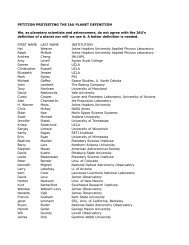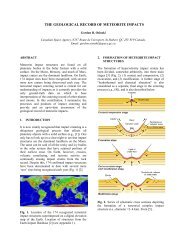Instrument calibration of the Hayabusa near-infrared spectrometer
Instrument calibration of the Hayabusa near-infrared spectrometer
Instrument calibration of the Hayabusa near-infrared spectrometer
Create successful ePaper yourself
Turn your PDF publications into a flip-book with our unique Google optimized e-Paper software.
(Figure 3), dark current characteristics and spectral transmission properties <strong>of</strong> <strong>the</strong> grating(Figure 4).<strong>Instrument</strong>-level <strong>calibration</strong>s <strong>of</strong> NIRS included measurements <strong>of</strong> <strong>the</strong> responsivity as afunction <strong>of</strong> wavelength and FOV <strong>of</strong> each detector element (to verify detector li<strong>near</strong>ity andalignment and to yield spectral resolution, spatial resolution, and flux <strong>calibration</strong> data),characterization <strong>of</strong> dark current levels for each detector element as a function <strong>of</strong> temperature,characterization <strong>of</strong> <strong>the</strong> level <strong>of</strong> spectral crosstalk on detector channels, and electronicperformance characteristics <strong>of</strong> <strong>the</strong> detector arrays. Finally, measurements <strong>of</strong> <strong>the</strong> <strong>calibration</strong>targets and some <strong>of</strong> mineral and rock samples were made with <strong>the</strong> assembled NIRSinstrument. The NIRS <strong>calibration</strong>s show that <strong>the</strong> detectors are li<strong>near</strong> and well aligned and that<strong>the</strong> instrument operates at very close to its design parameters for spatial and spectralresolution.4.1 Spectral CalibrationSpectral <strong>calibration</strong> was conducted in order to establish <strong>the</strong> wavelengths sensed by adetector for each <strong>of</strong> <strong>the</strong> 64 possible grating positions. That was performed by illuminating <strong>the</strong>instrument aperture with <strong>the</strong> monochromator, which is used in conjunction with anincandescent source and an integrating sphere. The signals from <strong>the</strong> detector arrays wererecorded with <strong>the</strong> monochromator wavelength scanned in 100 nm increments over <strong>the</strong>first-order wavelength range. The spectral <strong>calibration</strong> was performed under <strong>the</strong> ambienttemperature <strong>of</strong> 2°C. The results in <strong>the</strong> laboratory final test are shown in Figure 5. This figureshows <strong>the</strong> central wavelength <strong>of</strong> each <strong>of</strong> <strong>the</strong> detector arrays and <strong>the</strong> channel-to-wavelengthrelationship is expressed by:(1)where n is <strong>the</strong> channel number between 1 to 64. The accuracy <strong>of</strong> this equation for li<strong>near</strong>fitting is approximately ± 2 nm.Although <strong>the</strong> full range <strong>of</strong> <strong>the</strong> NIRS detector array is 751.8 to 2259.7 nm, it is fur<strong>the</strong>rlimited, however, to 850 to 2100 nm (channels 7-60). The lower six channels (channels 1-6, at2248-2130 nm) are <strong>near</strong> or in <strong>the</strong> detector cut<strong>of</strong>f (Figure 3), making <strong>the</strong> effective upper boundfor good signal-to-noise ratio (SNR) around 2100 nm for <strong>the</strong> signal level expected at Itokawa.The upper four channels <strong>of</strong> <strong>the</strong> InGaAs detector (channels 61-64, at 834-763 nm) register verylow signal due to fall-<strong>of</strong>f in detector responsivity and grism efficiency.7



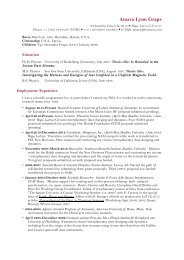
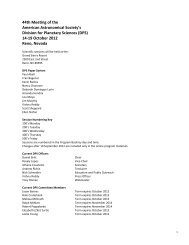
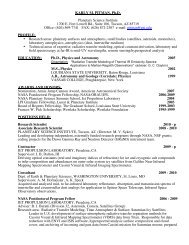
![Large-Aperture [OI] 6300 Ã
Photometry of Comet Hale-Bopp ...](https://img.yumpu.com/37144207/1/190x245/large-aperture-oi-6300-a-photometry-of-comet-hale-bopp-.jpg?quality=85)
